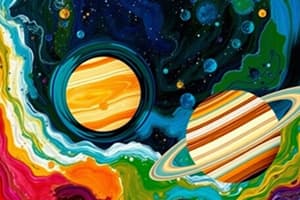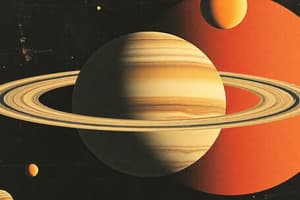Podcast
Questions and Answers
What is the main reason why Saturn appears yellow-brown to us?
What is the main reason why Saturn appears yellow-brown to us?
- Because of the high winds in its atmosphere
- Due to the heat it produces, which is 2.5 times the heat it receives from the sun (correct)
- Because of the massive size of the planet
- Because of the presence of its rocky core
How far away is the planet Saturn from us?
How far away is the planet Saturn from us?
- 99,000 kilometres
- 1.2 billion kilometres (correct)
- 1.2 million kilometres
- 766,000 kilometres
What is the composition of Saturn's atmosphere?
What is the composition of Saturn's atmosphere?
- Mostly oxygen
- Mostly hydrogen (correct)
- Mostly nitrogen
- Mostly helium
What is the thickness of Saturn's rings?
What is the thickness of Saturn's rings?
What is the characteristic of Saturn that allows it to be seen with the naked eye on a clear night?
What is the characteristic of Saturn that allows it to be seen with the naked eye on a clear night?
What is the primary component of Saturn's composition?
What is the primary component of Saturn's composition?
What is the approximate temperature of the hydrogen beneath Saturn's surface?
What is the approximate temperature of the hydrogen beneath Saturn's surface?
What is the approximate ratio of heat produced by Saturn to the heat it receives from the Sun?
What is the approximate ratio of heat produced by Saturn to the heat it receives from the Sun?
What is the characteristic of Saturn's winds?
What is the characteristic of Saturn's winds?
What is the significant feature of Saturn's rings?
What is the significant feature of Saturn's rings?
Flashcards are hidden until you start studying
Study Notes
Saturn: The Second Largest Planet
- Saturn is the second largest planet in the solar system, after Jupiter, with a size 766 times that of Earth.
- Despite being 1.2 billion kilometers away, Saturn can be seen with the naked eye on a clear night.
- The planet is classified as a gas giant, predominantly composed of hydrogen, with a possible small rocky core at its center.
Saturn's Atmosphere and Interior
- The hydrogen beneath the planet's surface is in a liquid state and extremely hot.
- The atmosphere of Saturn is mostly composed of hydrogen, with fierce winds that can reach speeds of up to 1,700 kph.
Saturn's Heat and Color
- Saturn produces 2.5 times the heat it receives from the sun, which is likely the reason for its yellow-brown appearance.
Saturn's Rings
- Saturn's rings are composed of ice fragments, less than 99 meters thick, but span thousands of kilometers into space.
Saturn: The Second Largest Planet
- Saturn is the second largest planet in the solar system, after Jupiter, with a size 766 times that of Earth.
- Despite being 1.2 billion kilometers away, Saturn can be seen with the naked eye on a clear night.
- The planet is classified as a gas giant, predominantly composed of hydrogen, with a possible small rocky core at its center.
Saturn's Atmosphere and Interior
- The hydrogen beneath the planet's surface is in a liquid state and extremely hot.
- The atmosphere of Saturn is mostly composed of hydrogen, with fierce winds that can reach speeds of up to 1,700 kph.
Saturn's Heat and Color
- Saturn produces 2.5 times the heat it receives from the sun, which is likely the reason for its yellow-brown appearance.
Saturn's Rings
- Saturn's rings are composed of ice fragments, less than 99 meters thick, but span thousands of kilometers into space.
Studying That Suits You
Use AI to generate personalized quizzes and flashcards to suit your learning preferences.




